My experience with T-Mobile AWAY, the wireless giant’s mobile internet solution, was mostly positive. It provided me with high download speeds, although there were limitations due to its priority on T-Mobile’s 5G network, and it was at times inconsistent, especially as I traveled away from the city or when I used it during rough weather. It was still a reliable solution that maintained its signal even while I was on the move. However, the more I used it, the more I concluded that the service has niche use-cases for specific types of customers.
My T-Mobile AWAY Review: Fast, Portable Internet—But Not For Everyone
My testing of T-Mobile AWAY showed me it's a reliable solution for families on the go and nomads

T-Mobile AWAY is a portable 5G I was able to connect to the internet nearly anywhere I went. Its speed and consistency could at times be inconsistent, but it performed well the majority of my time with it. | Photo by Andrea GutierrezPrieto for SatelliteInternet.com
What is T-Mobile AWAY?
T-Mobile AWAY is a version of its 5G Home Internet service that you can take with you anywhere in the United States. It’s ideal for your long RV trips and camping excursions. It’s even handy for business travel or working in a remote location away from the office.
Like fixed-wireless home internet, T-Mobile AWAY connects to a 5G network via cellular towers. It even uses the same gateway device as T-Mobile’s 5G Home Internet; the main difference is that it’s not tied to a single address and can be used anywhere the network is available. You’ll get the best signal the closer you are to populated areas, and it will get weaker the more remote you get. You need to be in the range of T-Mobile’s cellular towers, so if you’re not getting a phone signal, it’s unlikely your AWAY gateway will get a signal.
Jump to:
How I reviewed T-Mobile AWAY
Hi, I’m Andreas Rivera, a technology writer with a decade-long career reviewing products and services. I tested the T-Mobile AWAY service and gateway device over the course of two weeks in various locations, at different times of day, under different weather conditions, and while traveling.
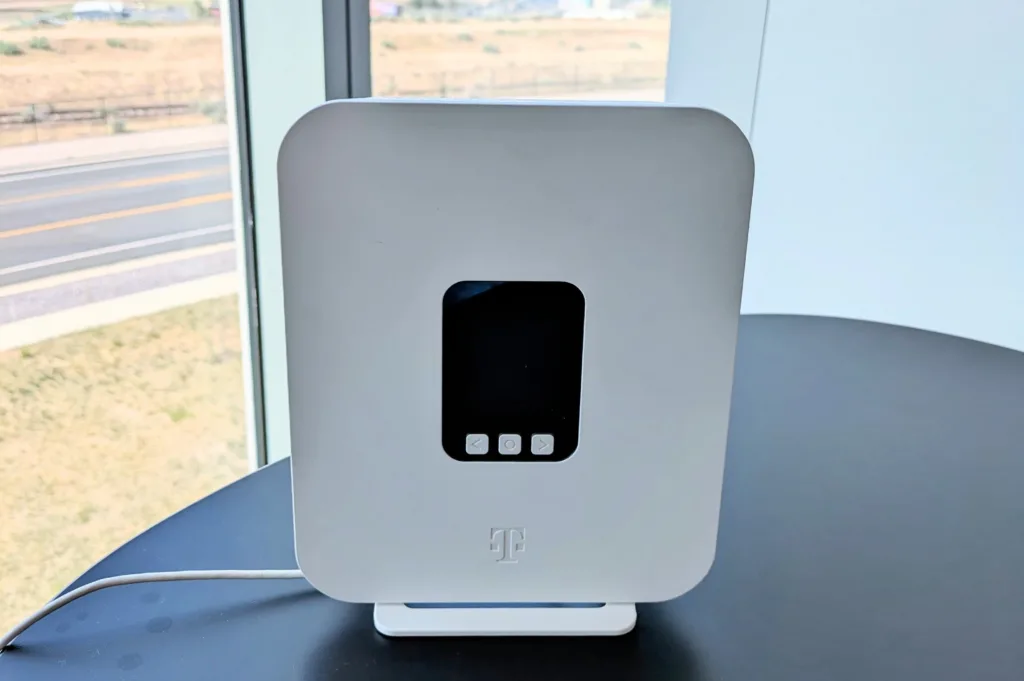
The only hardware required for T-Mobile AWAY is the 5G Gateway G4AR, which serves as both a wireless antenna and a Wi-Fi router. All that's needed is to plug it into a power source. | Photo by Andreas Rivera for SatelliteInternet.com
T-Mobile AWAY Plans & Pricing
T-Mobile AWAY offers two different plans: one with a 200GB data cap per month and another with unlimited data.
When you sign up for either AWAY plan, you’re provided a 5G Wi-Fi Gateway at no additional cost, unlike hotspot or phone tethering, which requires an upfront cost. You'll need to return the AWAY hardware when you cancel the service. If you want to keep the plan but don’t necessarily need it for long periods, you can pause service online or by calling customer support. However, you still need to pay a $10 monthly fee while your service is paused.
T-Mobile AWAY does not require a contract, but canceling service may still be a hassle. There is no option to cancel online, so to shut off service, I’ll have to make a phone call to customer service.
Buying T-Mobile AWAY and setting up the hardware was a breeze for me
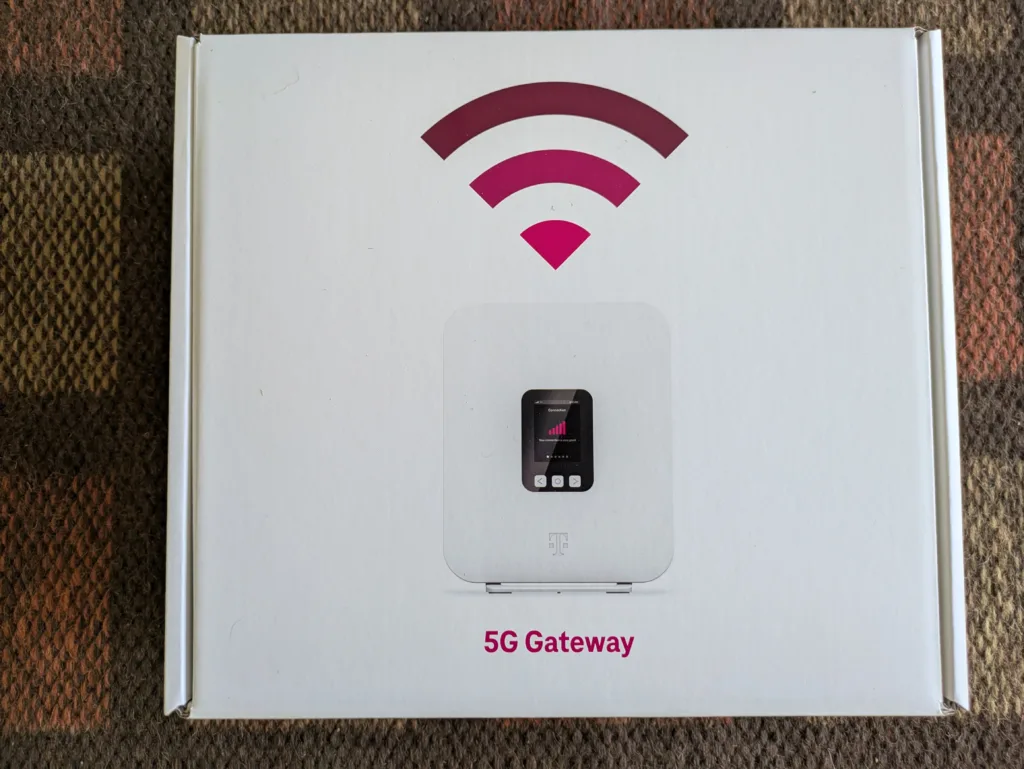
The T-Mobile AWAY gateway was promptly delivered to my home in just two business days, with everything needed to get started. | Photo by Andreas Rivera for SatelliteInternet.com
Getting started with T-Mobile AWAY was a pretty straightforward process for me. I was able to get online within two days of signing up. After selecting my plan and setting up a T-Mobile account, they shipped me the gateway device, which connects to the network and also acts as a Wi-Fi router. Most T-Mobile stores carry 5G internet gateways on-site, so it’s possible to sign up and get it set up for a trip on the same day.
The 5G gateway arrived on my doorstep within 48 hours. In the box, I found the gateway with SIM card, a USB-C power cord, and a stand with an adhesive strip. To go through the self-installation, I needed my mobile phone with the T-Life app downloaded to get set up.
I plugged in the gateway and waited for it to start up. The screen on the gateway powered on and instructed me to open the T-Life app on my phone. The app guided me step by step through setup and installation, starting with connecting the gateway’s Wi-Fi. My router needed to download an update, which took about five minutes to complete. In the app, I made a new network name and password. After about 10 minutes, I was browsing online through my T-Mobile AWAY.
The gateway itself is the size of most home routers and just as lightweight. It features two Ethernet ports, as well as connections to attach an external antenna, but that’s more relevant to home internet use.
I found T-Mobile AWAY to be pretty speedy—in most cases
According to its broadband nutrition label, T-Mobile AWAY offers download speeds of 91-361 Mbps when connected to 5G and 24-111 Mbps over 4G. As I tested the service using various speed test tools, I mostly got results within this range. On clear days, I could reach speeds of 150 to 300 Mbps. The highest speed I recorded was 372.97 Mbps.
However, I did experience occasional severe dips in performance, especially on days with stormy weather. In those cases, I experienced speeds around 20 Mbps. While still functional, it took much longer to load simple webpages and play videos. When streaming a show, the default resolution was low.
Slowest
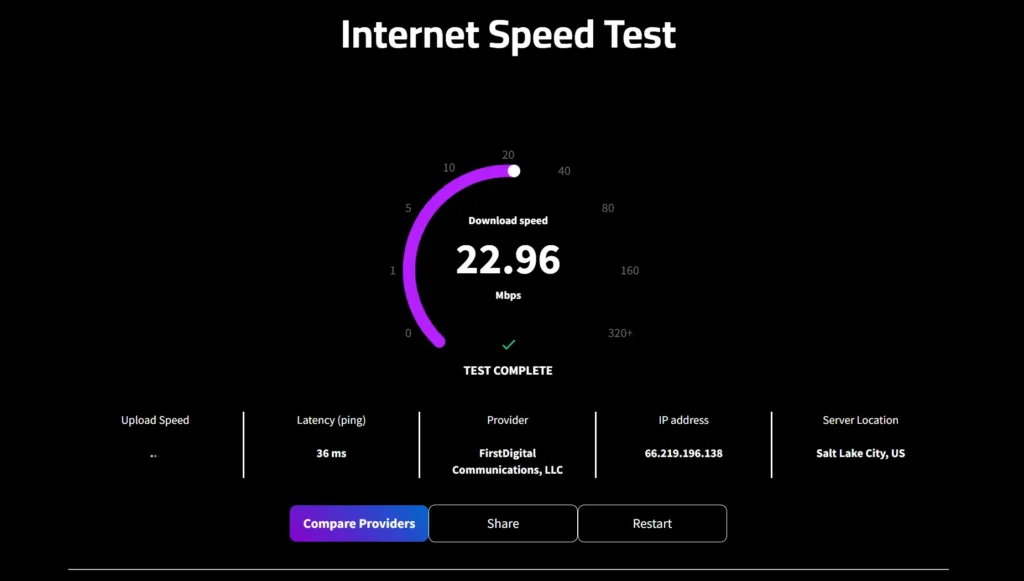
This was among the lowest speed results I got on T-Mobile AWAY. I recorded it during a rainstorm. Earlier in the day, before the storm, the speed was much higher. It was still usable, but pages took several more seconds to load, and videos even longer.
Fastest
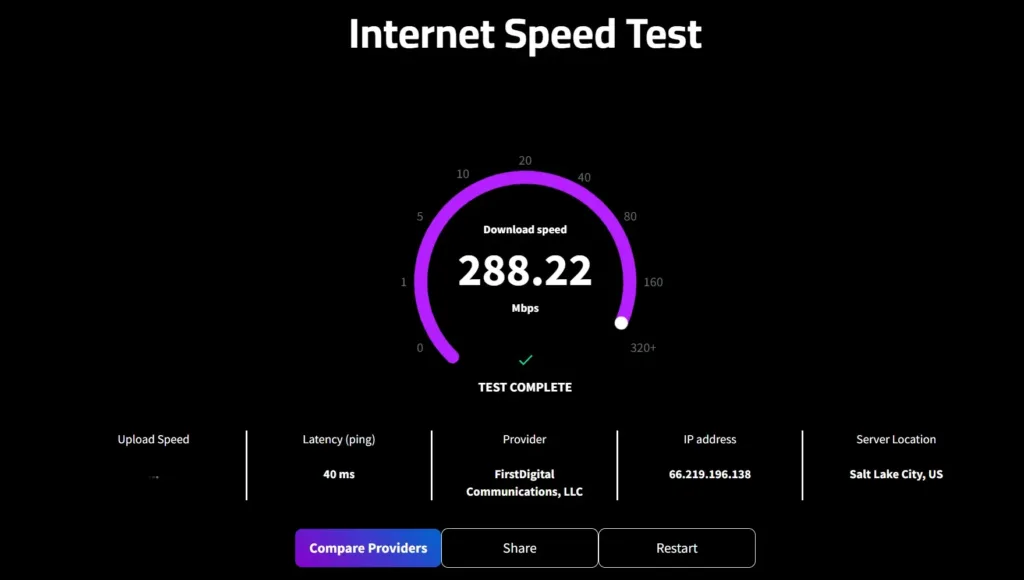
This was one of the highest results I got during my speed testing of T-Mobile AWAY. During clear days, and as long as the gateway was near a window or outside, I would get results like this. The performance was great, and I was able to browse pages and stream media without any issues.
Upload speed was often low, but still good enough for applications like video calling. I was able to maintain video calls with respectable resolution and no delay. The upload speed would likely make uploading large files slow. It also came with high latency, a problem inherent with most satellite internet, except Starlink, which I found has much lower latency.
The low upload speed and high latency make playing multiplayer games online nearly impossible. I was able to download games onto my Nintendo Switch without any problems, but playing fast-paced games that required quick reactions was a no-go.
T-Mobile AWAY always had a reliable signal, even in unexpected places
One thing that really impressed me about T-Mobile AWAY was how it consistently maintained a signal. While the speed varied a lot, I never experienced the service cutting out. I noticed performance dipping during peak hours in the evening, when more T-Mobile customers are likely to be using the network at home. However, even then, I could still access the internet.
I tested the device in several locations, including my home, work, a coffee shop, a park, and the wilderness. Speeds varied with each location, performing better the closer I was to the city. I also appreciated that the AWAY gateway device quickly boots up and connects to the T-Mobile network within a minute of powering it on.
I did experience significant declines in speed and responsiveness when I connected multiple devices to the Wi-Fi. While it could easily connect to them, I tested up to five different devices, and all exhibited slowdowns while streaming and downloading. I recommend connecting only two to three devices at a time for the best experience.
T-Mobile AWAY is mobile, high-speed 5G made for the road, but maybe not for the trail
The AWAY uses the same hardware and 5G network, but isn’t tied to a single location and taken anywhere. Unlike AWAY, T-Mobile 5G Home Internet is fixed to a single address and won’t work if it’s taken off-site.
I went driving with the AWAY device up a steep canyon. I expected the signal to cut out since I’d be far from and out of view of 5G towers. Surprisingly, as I streamed a video on my laptop, it never stopped to buffer during my 40-minute drive through the canyon. I was also able to make a video call at the top of the canyon with surprising quality.
Since it’s the same device used for home internet, the T-Mobile gateway is not exactly designed for easy travel in a backpack if you’re intent on taking your mobile internet on the trail. Although it’s small, it’s still a bit bulky and takes up a lot of room in a pack. Plus, powering it is a challenge that I’ll get into below.
To power my T-Mobile AWAY, I needed to get creative with power inverters and mobile power banks
One aspect I always consider with mobile internet solutions is how to power them. T-Mobile AWAY’s gateway has a power input of 100- 240V and comes with an AC adapter. It works plugged into any electrical outlet, which can be found in most modern RVs and other vehicles. However, you’ll need to improvise if you’re travelling without one, which is what I did.
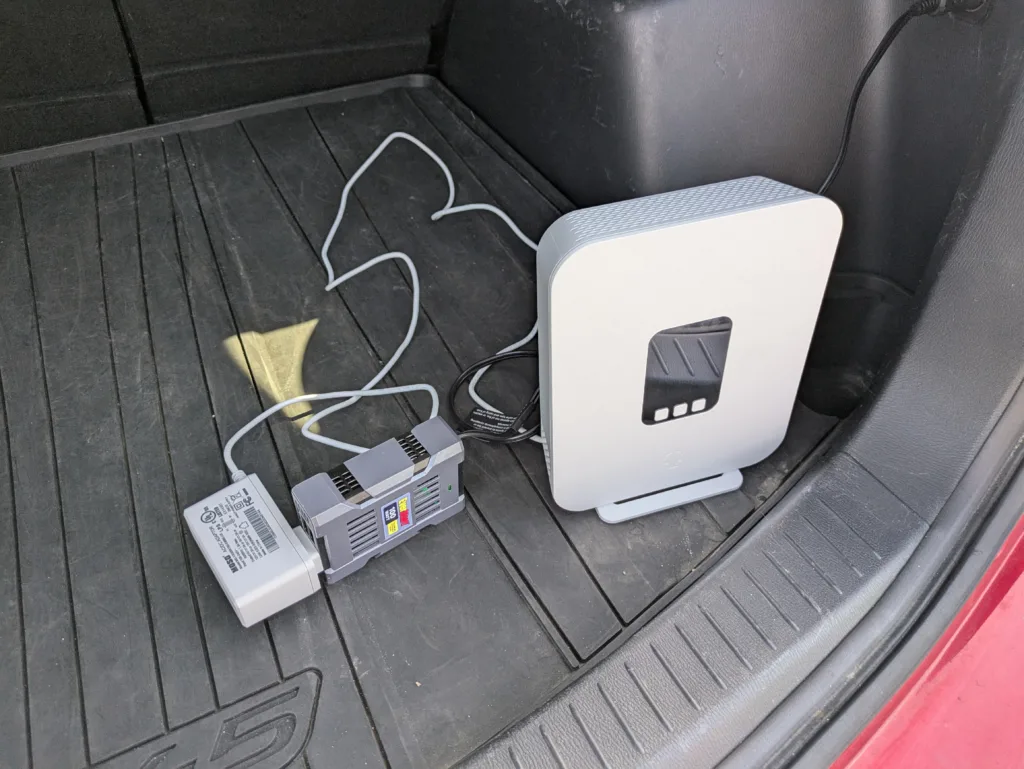
Unless your vehicle has an AC electrical socket, you'll need a DC power inverter plugged into a 12V socket like I needed. | Photo by Andreas Rivera for SatelliteInternet.com
My car doesn’t have a traditional outlet, but it does have a 12-volt power outlet, also known as the cigarette lighter. I used a 100-Watt DC power inverter to power the gateway in my car. It kept the gateway powered all throughout my travels. It even works while the car’s engine is off, but I wouldn’t recommend doing that for long, as it quickly drains your vehicle’s battery.
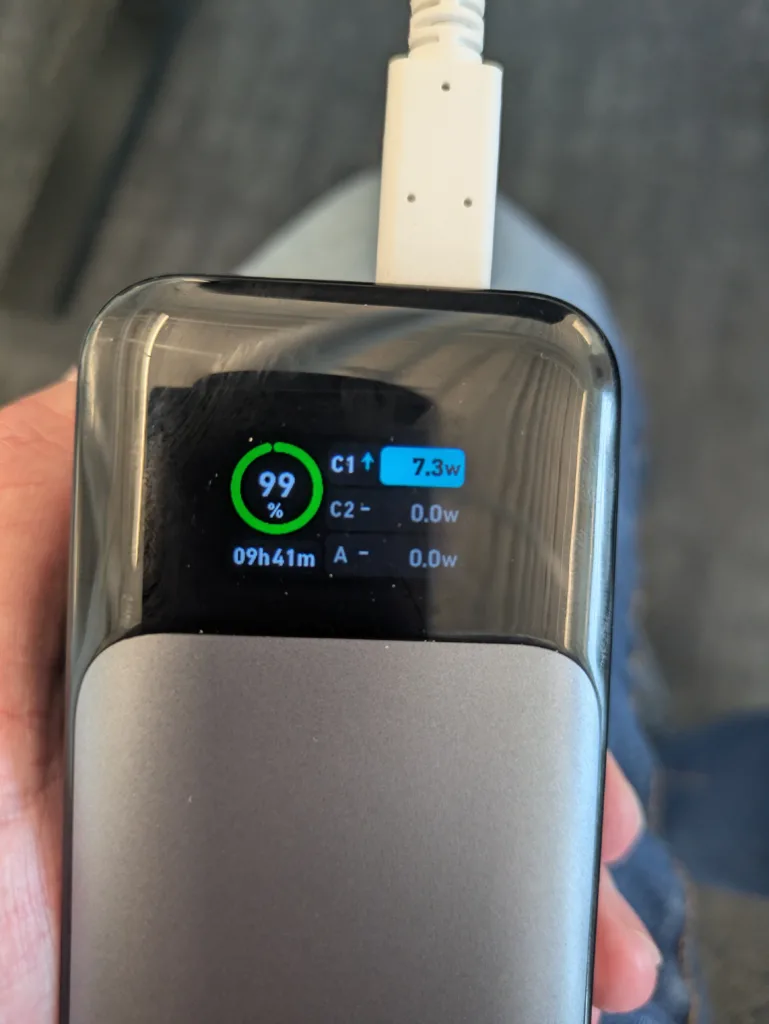
I recommend any portable power bank designed for charging laptops, as well as those that display the remaining battery life. | Photo by Andreas Rivera for SatelliteInternet.com
If you’re looking to get even more mobile with the AWAY gateway, you’ll need a reliable and portable power source. I found that it works with power banks rated for at least 100 watts, which is strong enough to power a laptop. I used the Anker 737 Power Bank, connected with a USB-C cable. I was able to take both with me on a long walk and stream my music and podcasts after turning off my phone’s 5G network. I saw that after about 30 minutes, it only used less than 10 percent of the battery, but mileage will vary depending on the power bank.
How did T-Mobile AWAY compare to my experience with satellite internet?
Currently, the only mobile satellite internet service is SpaceX’s Starlink service. I’ve reviewed Starlink Roam’s capabilities, including its very mobile Starlink Mini version. The two services’ download speeds are similar, although Starlink gave me more consistent speeds than T-Mobile AWAY. Starlink’s biggest advantage is that satellite internet can be used almost anywhere with little to no variation in service quality, whereas T-Mobile AWAY is dependent on the reach of its 5G network. As you get further from T-Mobile’s 5G network towers, you’ll likely get slower speeds, and if you go far enough afield, you won’t get service at all.
However, Starlink Roam is more expensive than T-Mobile AWAY. The biggest difference is that Starlink requires customers to purchase its equipment, while T-Mobile AWAY’s gateway device is included with the service. The Starlink Standard dish costs $349, and the Starlink Mini is $499. That is on top of the $165 per month you pay for Starlink’s Unlimited Roam plan. Although T-Mobile AWAY also has pricey service plans, the upfront costs are much more affordable.
Do I think T-Mobile AWAY is worth it? It depends on your use case
T-Mobile offers a unique solution for mobile internet that builds on its already popular 5G home internet service. T-Mobile heavily markets its AWAY plan to RV owners, which makes sense given its design and power needs. It’s a little less optimal for those camping without a convenient power source, but still usable with some extra investment like a power bank. It’s not an overall cheap solution on either plan. At $110 or $160 per month, it’s a costly way to get internet on the go, especially if you plan to use it only in the short term.
There’s the question of whether it’s worth it for travel when most people have smartphones capable of 5G connections, and that will depend on your use case. You can do a lot with your smartphone, but if you’re traveling and need to connect multiple devices, it’s a better option than using your phone’s hotspot data to run those devices. Smartphone hotspot data is often very limited, and the onboard Wi-Fi of a phone is not as powerful as that of the AWAY gateway. You’ll connect fewer devices and drain the battery faster.
I recommend the T-Mobile AWAY to those traveling in larger groups, such as a family, or for those who are indefinitely on the move, living a nomadic lifestyle. It’s not something I’d recommend to those going on short trips, backcountry campers, or backpackers.